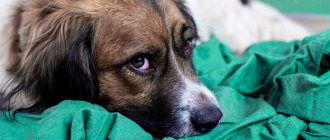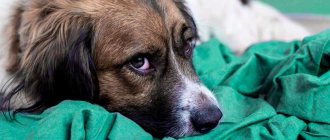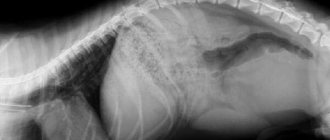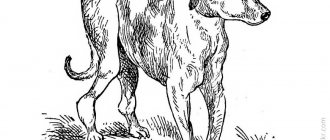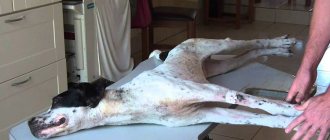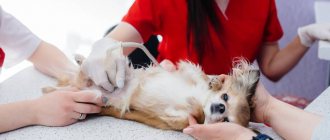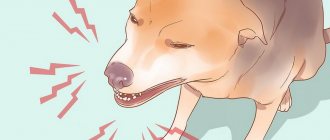Distemper in dogs is caused by a virus. It is also called Carré's disease. The disease exhibits resistance to various physicochemical factors. So, at a temperature of twenty-four degrees, bacteria can survive for five years. Statistics confirm the likelihood of puppies becoming infected with this virus from 3 to 12 months.
This state of affairs is due to weakened immunity due to changing teeth and intensive growth. Any dog can catch the virus. Basically, the disease progresses in the spring or autumn, which is explained by difficult weather conditions. The source of the disease is considered to be sick dogs. Birds and insects are carriers of the virus.
What is plague, types and symptoms
To properly deal with a disease, you must first study it. The word “plague” is rather diminutive and does not evoke the alertness that it should. You must understand that we are talking about canine plague - a highly contagious (highly contagious) viral disease.
Distemper in dogs is sometimes called "Carré's disease" after the scientist who discovered the virus for this disease.
According to the form of the disease
Pulmonary form. In this case, the organs of the respiratory system are mainly affected. First signs:
- Discharge of serous exudate (light yellow transparent watery discharge) from the nose. After some time, the exudate becomes purulent.
- Due to the discharge, the nostrils stick together and hardened crusts of pus appear.
- Itching, the dog scratches its face with its paws or tries to scratch itself on other objects.
- The dog has difficulty breathing, he sniffles, and wheezing can be heard.
- All of the above indicates inflammation of the lungs and nasal passages. Because of this, the temperature rises.
- In addition to damage to the lungs, the eyes are also affected. Inflammation in the eyes (the eyes turn red, watery eyes, the dog squints), up to the formation of ulcers.
The cutaneous form is characterized by a rash. At first these are red spots, which then, after 2 - 3 days, become inflamed and pustules form. Afterwards they rupture and pus covers the skin and fur. As a result, we end up with a dog with matted fur and hardened crusts of pus all over its body.
The intestinal form develops due to inflammation of the gastrointestinal tract. Characterized by the following symptoms:
- Diarrhea, in which you can often see blood, mucus and even particles of undigested food in the excrement. In this case, the stool itself is liquid, paler than usual (yellow-gray), then becomes darker. The smell is foul.
- Vomiting with mucus, and sometimes blood can be seen.
- A white coating appears on the tongue.
Nervous form. Most often, the disease manifests itself at the end as a severe complication, but in rare cases it can occur at the beginning:
- The dog is excited.
- Convulsions of individual muscles of the head or limbs are observed.
- Paralysis of the hind limbs may occur.
- Involuntary urination and defecation indicate paralysis of the sphincters of the bladder and rectum (in combination with heavy diarrhea, rectal prolapse is possible).
- Epileptic seizures (the most dangerous symptom, in this case the chance of helping the dog is extremely low).
- Loss of vision, smell or hearing.
- Pain in the fingers (where the nerve fibers end). At the same time, dogs gnaw fingers and squeal, howl and even groan in pain.
Mixed form. Most often observed. In this case, the dog is affected by several organ systems at once and the symptoms of different forms are mixed and can be observed both simultaneously and alternately.
According to the course of the disease
Lightning current. The most dangerous thing, because in this case it’s not that it’s impossible to help, but there’s simply no time. No clinical symptoms of the disease can be recognized. The animal simply dies suddenly.
Hyperacute course. Rarely seen. It proceeds rapidly, in just 2-3 days. You can hardly have time to help a sick dog. First, a sharp increase in temperature and refusal of food. The animal rapidly weakens, a comatose state sets in, which entails death.
Acute course. The most favorable thing possible, because we have time to help the dog. But you can't relax. In acute cases, quick and correct actions are important to save your pet.
Under no circumstances should you expect it to go away on its own.
In this case, the disease lasts 2 - 4 weeks. The development mechanism is something like this:
- The temperature rises to 39.5-40 degrees and lasts up to two weeks. Sometimes there is a temporary decrease in temperature. The pet is depressed and completely inactive. It may not even respond to commands and not react to familiar things; this is explained by the suppression of conditioned reflexes.
- Tries to hide in dark places.
- Gradually refuse food.
- Discharge from the nose and eyes appears on the 2nd day.
- At the same time, a rash appears.
- The next stage is gastrointestinal disorder. Diarrhea and vomiting. Against this background, dehydration develops, and therefore thirst increases.
- Towards the end of the disease, nervous phenomena appear.
It is worth noting that in one and a half month old puppies, plague occurs without an increase in temperature. And from the age of three months it is always accompanied by fever.
Sometimes after two to three weeks of illness there is a visible improvement, the dog begins to be active and even eat well, but after another 2 to 3 weeks (sometimes after 5 days) a sharp deterioration occurs. The body temperature rises and nerve damage immediately appears. In such cases of return of the disease, all phenomena are much more severe. In rare cases, the dog manages to survive.
Diet
We must not forget about special feeding during plague. Food should help boost immunity so that the body can fight harder:
- give more minced meat or finely chopped meat;
- raw egg - twice a week (during illness and during recovery);
- low-fat cottage cheese and kefir;
- broths from meat and vegetables are required; if you cook porridge, then make it liquid, like soup;
- A decoction of motherwort must be poured into drinking water during damage to the nervous system.
Routes of infection
Dogs of all breeds and ages can get sick.
The canine distemper virus has a very high virulence (ability to infect) and can be transmitted by almost any creature. It is dangerous only for carnivores: dogs, ferrets and some wild animals. But carriers can be:
- rodents;
- People;
- insects;
- birds;
- and of course infected animals.
Recently recovered dogs are also carriers (they still carry the virus 2-3 months after illness).
And the pathogen enters the body either through the respiratory tract or through the digestive system.
Important! Your pet does not have to be near a carrier of the disease. Your dog is also at risk of coming into contact with the pathogen on the street if an infected animal was walking in the same place, or if it comes into contact with the care items of a sick animal.
To whom is the virus transmitted?
Can the infection be transmitted to another dog? Veterinarians give a positive answer to this. This viral infection has the ability to be transmitted by airborne droplets. Therefore, it is enough for a dog to breathe on another pet to infect it.
At the first symptoms of the disease, the owner can begin a course of treatment for the dog. The infection is not transmitted to humans. The first priority in treatment is keeping the house clean. If there is an unvaccinated pet in the room, the floor covering should be regularly treated with disinfectants.
Treatment
For correct treatment, it is necessary to confirm the diagnosis. This can be done at a veterinary clinic by donating your pet’s blood for a hematological analysis.
Treatment must be started urgently and it must be effective, so immediately seek help from a veterinary specialist, do not try to cope with folk treatment yourself at home!
In the clinic, all activities will be aimed at increasing the overall resistance of the body (resistance is the body’s ability to resist pathological processes).
First aid is aimed at stopping the acute condition of the pet. If the intestinal form predominates, then first of all, with the help of medications, vomiting and debilitating diarrhea are stopped, the body is brought out of a state of dehydration, for this it is necessary to put the dog under a drip with a solution of sodium chloride or glucose.
Then calcium gluconate, the dose of which must be strictly calculated by the veterinarian, and B vitamins are administered intramuscularly.
They also prescribe solutions aimed at reducing the tone of skeletal muscles, so doctors prevent paresis.
If you are offered to give your pet a novocaine blockade, do not be alarmed; these actions are resorted to in the presence of nervous phenomena (nervous tics), because treating a dog whose nervous system is damaged is not an easy task.
Medications are often needed to help reduce agitation. A solution that is administered intramuscularly or powder. If the plague is complicated by bacterial infections, antibiotics are prescribed. In addition, immunomodulators are prescribed, which help restore the body’s immune system.
Pathogen
The causative agent of canine plague is an RNA-containing morbillivirus, which contains two immunogen proteins that can cause a powerful elimination reaction in the body (elimination, destruction of a foreign compound). However, due to the presence of a ribonucleic acid molecule in the structure of the virus, it is integrated into the DNA of the host organism, providing itself with protection from suppression by the immune system.
The plague virus is resistant to prolonged exposure to low temperatures; it can remain viable for up to 5 years at -20°C. However, at +60 °C it dies in 30 minutes, and when boiled - instantly. Disinfectants destroy the virus quite quickly: solutions of Lysol, caustic soda, phenol and formalin - in 1-2 hours, and ultraviolet rays - within 30 minutes.
Prevention of canine distemper
The basis of prevention is timely vaccination of the animal! Preparations that promote the development of immunity against plague are contained in almost all complex vaccines, so you simply need to vaccinate your pet in a timely manner according to the usual vaccination schedule and repeat vaccinations annually!
In addition to this basic rule, a few more points must be observed to maintain the dog’s immunity:
- healthy balanced diet;
- timely deworming;
- staying active is very important for your pet;
- do not allow inbreeding;
- Do not use other people's dog grooming products.
Reviews
The opinions of dog owners differ, but they confirm the fact that everything depends on the animal. Moreover, some veterinarians resort to this popular method and are right. Someone vehemently opposes treating their four-legged friends with this antediluvian method, because they have already lost a dog once.
Someone treated sick puppies this way when antibiotics did not help, and now advises everyone they know to treat distemper exclusively with vodka. Each individual case requires its own treatment methods. The best way is to consult a veterinarian.
Which dogs are at risk?
Puppies are primarily at risk. Puppies that are still nursing their mother are protected by colostral immunity. They receive it along with milk from their mother even two weeks after weaning.
But after that, they become completely defenseless. Therefore, it is necessary to vaccinate the dog while it is still protected by maternal immunity.
Until a full-fledged protective reaction is formed, it is very important to maintain strict quarantine in order to protect the baby.
Despite the fact that any breed of dog can get sick, there is a breed predisposition. Shepherd dogs, Siberian husky, hunting and decorative breeds are the least resistant to carnivore plague.
Diagnostics
Before the veterinarian prescribes treatment, a number of laboratory diagnostic tests are carried out. For analysis, discharge is taken from the eyes, nose, and genitals of the dog. Anamnesis data, external manifestations, ultrasound, MRI, CT results are taken into account.
Differential diagnosis is mandatory due to the similarity of symptoms with other diseases. For example, the manifestations of the nervous form of plague are in many ways similar to the symptoms of rabies in dogs.
To make an accurate diagnosis, PCR and ELISA tests are prescribed. They also conduct other test studies and express diagnostic methods. Until the puppy is diagnosed, it is quarantined to avoid infecting healthy animals.
FAQ
Is canine distemper transmitted to humans and other animals?
The virus does not pose any danger to humans. And it is transmitted to other animals if they are canines, since the virus is specific to them. But do not forget that any animals, as well as people, can become carriers of the virus.
Is distemper treatable in dogs and what is its incubation period?
Yes, it is possible to cure if it is not a hyperacute form and you turn to specialists in time. The incubation period lasts 2-3 weeks, sometimes longer.
What to feed a dog with distemper?
Nutrition is very important during illness and should contain as many vitamins as possible. If possible, you can give meat. If the dog refuses to eat, we feed it with a syringe without a needle with specially developed pates from the line of veterinary diets.
Can a vaccinated dog get distemper?
No vaccine provides 100% protection against the virus. But vaccinated dogs get sick much easier, sometimes even unnoticed by the owner. It may simply be a mild gastrointestinal disorder for 1-2 days, without other clinical symptoms
Can it be cured with vodka?
No! Of course, ethanol is used for medicinal purposes, but not in this form and not in this case!
How much does a vaccination cost?
You need to find out prices for vaccination specifically at the clinic where you are going to go.
How often should I get vaccinated?
Anti-distemper drugs are included in complex vaccines and should be injected according to the scheme described in the instructions. Recommended vaccination schedule: 8 weeks, 11 weeks, 15 weeks, then 12 months after the last vaccination.
How long do dogs live after distemper?
Depends on what consequences the disease left behind. If the plague occurred with nervous symptoms, then a tic, or loss of vision, etc. can remain with the pet for life and affect the quality and number of years lived.
How to treat the booth?
The place where the sick dog is kept must be treated with a 2% formaldehyde solution, and the bowls must be boiled.
Preventive actions
Vaccination (specific method) is carried out with vaccines KF 668, EPM of domestic production. Polyvalent vaccines such as Hexadog, Vanguard and others are considered the most effective. Vaccination of puppies is recommended at 2-3, 6 months, one year and every year thereafter. The vaccination is done in two stages (0 day and on the 14th day - the second injection). Vaccination is carried out at an early age, since the mother’s immune system can protect it only up to three months. Animals tolerate the procedure easily.
The doctor must make a note in the veterinary passport about the vaccination. The quarantine is three weeks. Moreover, during this period it is not advisable for the animal to have contact with other individuals. It is recommended to thoroughly wash the floors and clean shoes twice a day. Disinfection in the room is carried out with a chloramine solution. It is believed that the virus persists at low temperatures, so the room in which the dog is kept must be warm.
Statistics show that vaccination protects an animal from infection by 99%. It has been established that puppies may not survive infection, but in adult animals the chances are 50 to 50. If a puppy with a latent stage of the disease is vaccinated, he will not be able to survive.
If the puppy is infected immediately after the vaccine is administered, then the probability of survival is low, since immunity has not yet developed. Before this, the dog must be dewormed and have its body temperature measured. You should be vaccinated a month before your intended visit to exhibitions and places where animals gather in large numbers.
Vaccination against distemper for animals
Vaccination does not guarantee against infection. It prepares the animal’s body so that it can cope with the disease. It has been established that a vaccinated animal tolerates the disease more easily. Within three months, a dog who has recovered from the disease can infect other dogs.
You should not allow your pet to come into contact with stray dogs, drink from a puddle, or lick feces. It is necessary to carefully select a place for walking your dog. After each walk, you need to wipe your paws and periodically change or wash the bedding. The dog owner must contribute to his recovery. It is important to massage and create a balanced menu during the recovery period.
Nutrition should be different. Meat is a source of natural protein and should form the basis of the diet. It can be replaced with offal. To diversify the diet, vegetables are added to porridge: parsnips, bell peppers, beets. Compliance with all the rules will allow the animal to remain healthy.
Currently reading:
- Primary and important symptoms of rabies in dogs
- We fight warts on the face and body of dogs
- Ways to manage parvovirus infection in dogs
- Thyroid dysfunction in dogs (hypothyroidism)
Vodka with garlic as an anthelmintic
Some dog lovers use vodka with garlic as a dewormer. Garlic is an antiparasitic agent. Vodka temporarily immobilizes helminths, so that during bowel movements much more of them come out than usual. Alcohol has no effect on helminth eggs.
But alcohol is very harmful to the liver, so vodka with garlic can be given only in the most extreme cases, when no other deworming agents can be obtained. The product is contraindicated for puppies under one year of age, pregnant and lactating females. Vodka with garlic is much less effective than pharmaceutical preparations.
Recovery prognosis
Canine plague is one of the most difficult diseases to treat. The probability of death is very high: even with timely initiation of therapy, it is 50%. Without professional treatment in a veterinary clinic, 80% - 90% of animals die.
Immunity plays a big role in recovery. The stronger it is, the greater the dog’s chances of recovery.
Every fifth dog who recovers from the disease develops complications. Which ones exactly depend on the form of the plague. Since the most serious consequences are the nervous type of HCP, it is advisable to overcome the pathology before it reaches this stage.
